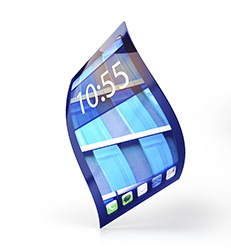Designing flexible and smart electronic solutions of the future
Flexible displays for mobile devices, smart therapeutic bandages for monitoring the recovery of wounds and wearable electronics for improving athletic performance are all Organic Light Emitting Diode (OLED) and Organic Photovoltaic (OPV)-based applications. This means they are heavily dependent on the use of indium tin oxide (ITO) for manufacturing their transparent conducting films, an expensive constraint that represents an obstacle to the widespread commercialisation of flexible electronics. This is why the pan-European project FLEXIBILIS, launched in 2013, aims to develop alternative technologies and materials in order to deliver low cost, sustainable and flexible printed electronic applications. The initiative has already demonstrated some promising results in replacing ITO. The Centre for Process Innovation (CPI), which is leading this project, recently produced what it calls defect-free OLED lighting demonstrators with emissive areas of greater than 250cm2. The next step will be to refine and apply these results to actual demonstration devices. Finally, the project will seek to manufacture these materials at a scale capable of supporting market growth. The market opportunities for flexible electronics – which can be folded and even crumpled up – are huge. The technology allows electronic circuits and devices to be produced using relatively low cost printing processes onto any surface, whether rigid or flexible, and over large areas. This gives designers the opportunity to embed technology and functionality into their products, creating the opportunity for new, innovative components that are wireless, interactive, thinner and lightweight. A smart bandage with embedded electronics, for example, can be worn as if it were a conventional bandage. The technology can also be used to install efficient lighting over a large area, develop low cost solar cells as well as flexible and environmental friendly batteries. It is these types of promising applications that the FLEXIBILIS project aims to tap into. The global market value of flexible electronics – also known as Organic and Large Area Electronics (OLAE) – is forecast to increase from a little over EUR 1 billion today to more than EUR 200 billion by 2027. It is vitally important therefore that Europe takes a lead in the development of new applications. A key objective of the FLEXIBILIS programme is therefore to improve the supply chain, to ensure that new products can be brought to market as efficiently as possible. FLEXIBILIS is the result of an OLAE+ transnational call for collaborative research and development proposals under the European Commission’s ERA-NET Plus scheme. The aim of the OLAE + programme is to attract, qualify and support proposals to develop and stimulate the technology and business relationships within the European electronics market, building the supply chain and removing barriers to industrialisation. Europe already has a lead in the development of flexible electronics technology as well as a vibrant emerging supply chain that must be supported and strengthened. The FLEXIBILIS project will go some way to ensuring that this is achieved. For further information, please visit: http://www.uk-cpi.com/
Countries
United Kingdom



